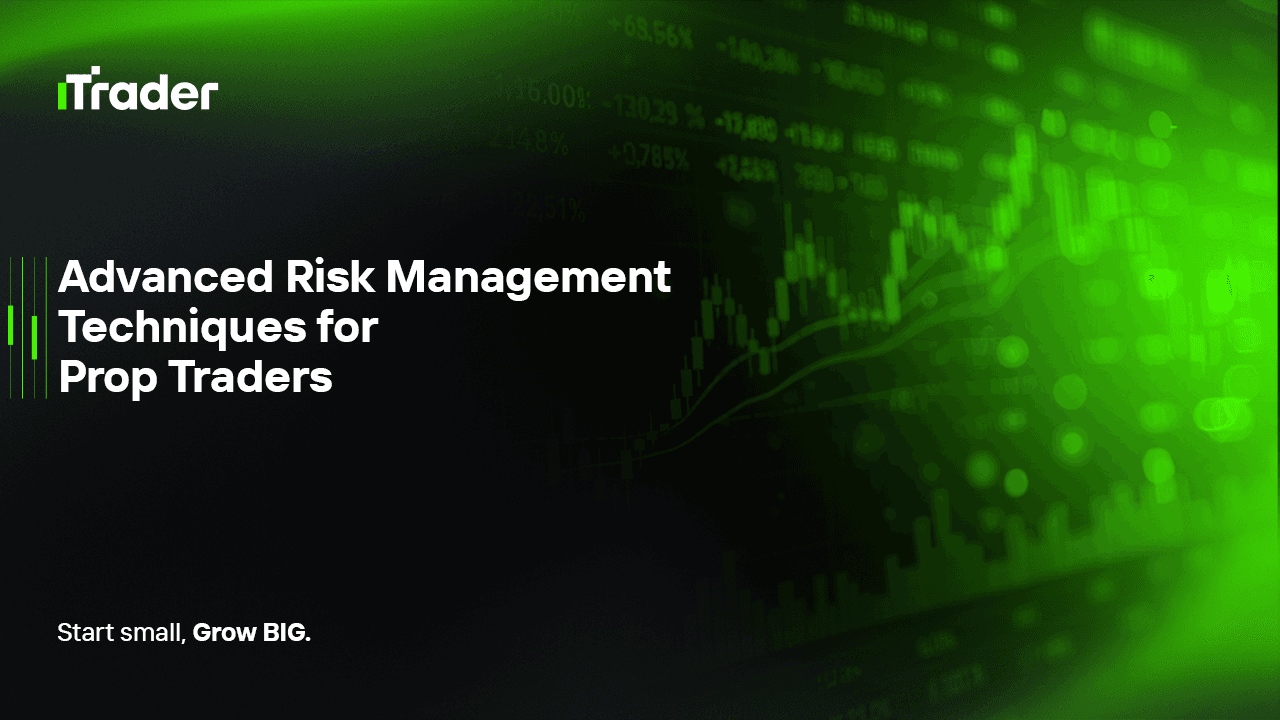2025-07-21
Trading for a proprietary firm differs significantly from retail trading, primarily in the approach to risk and responsibility. Managing someone else's capital under strict performance thresholds requires a more refined, systematic, and adaptive risk management framework.

In this blog, we break down the advanced techniques used by prop traders to control exposure, respond to changing conditions, and ensure long-term strategy survival.
AI Summary:
This blog outlines advanced-level risk management strategies specifically designed for professional proprietary traders. In volatile and uncertain markets, preserving capital and maintaining consistent performance require more than basic tools. We explore dynamic position sizing, correlation-aware exposure, trade clustering, adaptive drawdown controls, risk-of-ruin analysis, and Monte Carlo simulation, among other modern methodologies. These approaches help traders navigate institutional expectations, reduce structural risks, and develop robust trading systems.
For prop traders, the number one priority is not just generating profit, but avoiding destruction. In a high-risk environment, the following principles are fundamental:
Basic fixed-lot or fixed-percentage sizing is not enough for advanced trading. Instead, more adaptive approaches are used:
Adjusts trade size based on current market volatility.
Formula:
javaCopyEditPosition Size = (Risk Capital per Trade) / (ATR * Multiplier)
Adjusts position size based on recent equity curve performance.
Prop traders often run multiple strategies and instruments simultaneously, making correlation management essential:
Measures how similar different strategies respond to market conditions.
Losses don’t always occur randomly; they often form clusters. These are referred to as “structural drawdowns.”
Use psychological and statistical limits to manage open exposure.
RoR calculates the likelihood that a trading strategy will completely deplete capital.
iniCopyEditRoR = [1 - (B/A)] ^ A
Since market results are rarely linear, Monte Carlo simulation helps:
While some firms impose hard exposure caps (e.g., 5 lots total), advanced traders apply:
Dynamic caps based on real-time risk conditions.
Risk control must account for external conditions, not just internal metrics.
Top proprietary traders recognize that mental state is part of risk exposure.
Defend against overconfidence, revenge trading, confirmation bias
Advanced prop trading requires Order Management Systems (OMS) and Risk Management Systems (RMS):
Success in proprietary trading isn’t just about finding profitable strategies—it’s about managing risk with surgical precision. Beyond basic stop losses and 1% rules, serious traders employ techniques like correlation analysis, volatility-adjusted sizing, trade clustering, adaptive drawdown thresholds, and Monte Carlo simulations to build resilient systems.
Ultimately, the goal is not just to survive, but to thrive with consistency, clarity, and emotional control, even in the most unpredictable market environments.
© 2025 iTrader Global Limited | หมายเลขทะเบียนบริษัท: 15962
iTrader Global Limited ตั้งอยู่ที่ Hamchako, Mutsamudu, เกาะปกครองตนเอง Anjouan, สหภาพคอโมโรส และได้รับใบอนุญาตและอยู่ภายใต้การกำกับดูแลของคณะกรรมการหลักทรัพย์แห่งคอโมโรส ภายใต้หมายเลขใบอนุญาต L15962/ITGL
iTrader Global Limited ดำเนินการภายใต้ชื่อทางการค้า “iTrader” และได้รับอนุญาตให้ดำเนินกิจกรรมการซื้อขายฟอเร็กซ์ โลโก้ เครื่องหมายการค้า และเว็บไซต์ของบริษัทเป็นทรัพย์สินเฉพาะของ iTrader Global Limited
บริษัทย่อยอื่น ๆ ของ iTrader Global Limited ได้แก่ iTrader Global Pty Ltd หมายเลขทะเบียนบริษัทออสเตรเลีย (ACN): 686 857 198 โดยบริษัทนี้เป็นตัวแทนที่ได้รับอนุญาต (หมายเลขตัวแทนบริการทางการเงินของออสเตรเลีย (AFS): 001315037) ของ Opheleo Holdings Pty Ltd (ใบอนุญาตบริการทางการเงินของออสเตรเลีย (AFSL): 000224485) ซึ่งมีที่อยู่จดทะเบียนอยู่ที่ Level 1, 256 Rundle St, Adelaide, SA 5000 ข้อจำกัดความรับผิดชอบ: นิติบุคคลนี้ไม่ใช่ผู้ออก และไม่รับผิดชอบต่อผลิตภัณฑ์ทางการเงินที่ซื้อขายบนหรือผ่านเว็บไซต์นี้
คำเตือนความเสี่ยง: การซื้อขาย CFD มีความเสี่ยงสูงต่อการสูญเสียเงินทุนอย่างรวดเร็วเนื่องจากเลเวอเรจ และอาจไม่เหมาะสมกับผู้ใช้ทุกคน
การซื้อขายกองทุน CFD และผลิตภัณฑ์ที่มีเลเวอเรจสูงอื่น ๆ ต้องการความรู้เฉพาะทาง
จากผลการวิจัยพบว่า 84.01% ของผู้เทรดที่ใช้เลเวอเรจประสบกับการขาดทุน
โปรดตรวจสอบให้แน่ใจว่าคุณเข้าใจความเสี่ยงทั้งหมด และพร้อมที่จะสูญเสียเงินทุนก่อนที่คุณจะเข้าร่วมการซื้อขายที่มีเลเวอเรจ
iTrader ขอประกาศว่า บริษัทจะไม่รับผิดชอบต่อความเสี่ยง ความเสียหาย หรือการสูญเสียใด ๆ ที่เกิดขึ้นจากการซื้อขายแบบมีเลเวอเรจต่อบุคคลหรือนิติบุคคลใด ๆ ทั้งสิ้น
ข่าวสารและข้อมูลที่ปรากฏบนเว็บไซต์นี้มีไว้เพื่อวัตถุประสงค์ทางการศึกษาเท่านั้น ผู้ใช้ควรตัดสินใจทางการเงินอย่างอิสระและโดยใช้ข้อมูลอย่างรอบคอบ
ข้อจำกัด: iTrader ไม่ได้มุ่งเป้าเว็บไซต์หรือบริการไปยังผู้อยู่อาศัยในประเทศที่กฎหมายหรือข้อบังคับห้ามไม่ให้มีการทำธุรกรรมดังกล่าว
หากคุณอาศัยอยู่ในเขตอำนาจที่การใช้เว็บไซต์หรือบริการนี้ถูกจำกัด คุณต้องรับผิดชอบในการปฏิบัติตามกฎหมายท้องถิ่น
iTrader ไม่รับประกันว่าเนื้อหาบนเว็บไซต์ของบริษัทจะเหมาะสมหรือถูกต้องตามกฎหมายในทุกพื้นที่